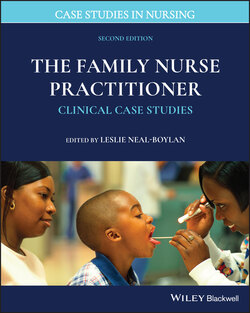Читать книгу The Family Nurse Practitioner - Группа авторов - Страница 63
ОглавлениеCase 6.10 Headache
By Leslie Neal‐Boylan, PhD, APRN, CRRN, FAAN, FARN
SUBJECTIVE
Sophia is a 35‐year‐old Latina woman who presents with a complaint of headaches that have been occurring more frequently over the past 2 weeks. She has never had any problems with headaches before. Rarely, she has had a headache after a stressful day but denies premenstrual headaches or frequent headaches until 2 weeks ago. Her headaches are left sided in the temporal area and are severe (7 out of 10 on a 1–10 scale) and throbbing. They occur 3−5 times each week. She occasionally becomes nauseous but rarely vomits. The headaches tend to last several hours and go away if she is able to get sleep. Sophia tries to retreat to a dark and quiet corner when the headaches begin. She sometimes sees “spots in front of her eyes” right before the onset of a headache. Otherwise, she has no trouble with her vision, has had no epistaxis, upper respiratory symptoms, or sinus symptoms. She denies trauma to her head or any neck stiffness. She denies fever, chills, numbness, or weakness.
Past medical history: Sophia has been otherwise well and denies any previous surgeries or hospitalizations other than for 3 vaginal deliveries without complications.
Family history: Migraine headaches in her mother and sister. Her uncle had a benign brain tumor that was successfully treated.
Social history: The patient does not smoke, drinks 1 beer 3 times each week, and denies ever using recreational drugs. She is married and works as an administrative assistant in a busy office. She has 1 preteen and 2 teenagers at home, and their behavior sometimes causes her stress. Her husband is supportive and helpful.
Medications: Sophia’s medications include occasional ibuprofen for “aches and pains.” She tried the ibuprofen for the headaches without relief. She takes no other medications. She states that her mother told her that she was allergic to penicillin as a child, but she doesn’t know why.
OBJECTIVE
General: Sophia is well groomed. Her manner and speech are appropriate and she is articulate. She is in no apparent distress during the visit.
Vital signs: The patient is afebrile. Her blood pressure is 140/90 (which she says is higher than her normal blood pressure). Pulse is 86, and respirations are regular at a rate of 12.
HEENT: The eye exam reveals clear sclera, conjunctiva without injection, and PERRLA. EOMs are intact. There is no AV nicking or papilledema. Optic disks have clear margins. Nasal mucosa is without erythema or drainage. There is no sinus tenderness to palpation. Cranial nerves II–XII are grossly intact.
Cardiac: Unremarkable.
Respiratory: Unremarkable.
Neurologic: The patient is alert and oriented. Thoughts are coherent and articulation is clear and appropriate. Sensation and proprioception are grossly intact, and the Romberg test is negative. Gait is steady. Brudzinski and Kernig signs are negative.
CRITICAL THINKING
1 What is the most likely differential diagnosis and why?___Migraine with aura___Migraine without aura___Cluster headache___Tension headache___Meningitis___Temporal arteritis___Psychogenic headache
2 Are there tools that can be used to help assess this headache? If so, name two.
3 Which diagnostic studies should be considered?___CT scan___MRI___CBC___CMP___Lipid panel
4 What is the plan of treatment?
5 Are any referrals or follow‐up needed?
6 Does the patient’s psychosocial history impact how she might be treated?
7 Is the patient’s blood pressure the cause or the result of her headache?
8 Would the treatment change if the patient were a smoker or on birth control pills?
